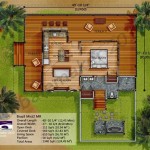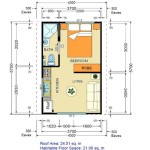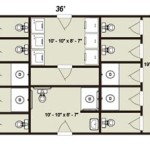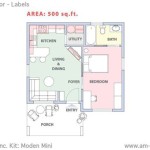One-Story Bungalow Floor Plans: A Comprehensive Guide
Bungalows, characterized by their low-pitched roofs, wide overhanging eaves, and prominent front porches, have long been a popular choice for homeowners seeking a blend of comfort, style, and functionality. The one-story bungalow, in particular, offers accessibility and ease of living that appeals to a wide range of individuals and families. This article delves into the intricacies of one-story bungalow floor plans, exploring their defining features, advantages, common layout variations, and considerations for customization.
A bungalow's defining characteristic lies in its horizontal emphasis, often achieved through a single story or a story-and-a-half design. The one-story variant eliminates the need for stairs, making it an ideal choice for individuals with mobility limitations, families with young children, and those simply seeking a more streamlined and accessible living space. Bungalow floor plans often prioritize open-concept living areas, blurring the lines between the living room, dining room, and kitchen. This design fosters a sense of spaciousness and encourages social interaction within the home.
The architectural style of bungalows often incorporates natural materials, such as wood and stone, and emphasizes a connection to the outdoors. Features like large windows, French doors, and expansive porches invite natural light and fresh air into the home, creating a comfortable and inviting atmosphere. One-story bungalows are particularly well-suited for smaller to medium-sized lots, as their single-level construction allows for efficient use of space and minimizes the building's footprint.
Advantages of One-Story Bungalow Floor Plans
The popularity of one-story bungalow floor plans stems from their numerous advantages, catering to a diverse range of lifestyle needs and preferences. These benefits extend beyond mere aesthetics, encompassing practical considerations related to accessibility, maintenance, and overall livability.
Accessibility and Universal Design: One of the most significant advantages of a one-story bungalow is its inherent accessibility. The absence of stairs eliminates a major barrier for individuals with mobility issues, making it an ideal choice for aging in place or accommodating family members with disabilities. This feature aligns with the principles of universal design, which aims to create living spaces that are usable by people of all ages and abilities. Features like wider doorways, roll-in showers, and accessible kitchen counters can be seamlessly integrated into a one-story bungalow floor plan to further enhance its accessibility.
Ease of Maintenance: Maintaining a one-story home is generally easier and less expensive than maintaining a multi-story home. Exterior maintenance, such as painting and gutter cleaning, can be completed without the need for ladders or specialized equipment. Interior cleaning is also simplified, as there are no stairs to navigate. Furthermore, heating and cooling costs may be lower in a one-story bungalow, as heat rises in multi-story homes, leading to temperature imbalances. The streamlined design of one-story bungalows lends itself to efficient upkeep, providing homeowners with more time to enjoy their living space rather than spending it on tedious chores.
Enhanced Safety: In the event of a fire or other emergency, a one-story home offers a quicker and safer escape route compared to a multi-story dwelling. All occupants can exit the home directly onto ground level, eliminating the need to navigate potentially hazardous stairs. This feature is particularly beneficial for families with young children or elderly individuals who may have difficulty descending stairs quickly. The simplified layout of a one-story bungalow also makes it easier for firefighters and other emergency personnel to access all areas of the home.
Common One-Story Bungalow Floor Plan Layouts
While the defining characteristics of a bungalow remain consistent, the internal layout of one-story bungalow floor plans can vary significantly to accommodate different needs and preferences. Common layout variations include the linear layout, the U-shaped layout, and the L-shaped layout, each offering distinct advantages in terms of privacy, functionality, and spatial organization.
Linear Layout: The linear layout is characterized by a straight, elongated design, with rooms arranged sequentially along a central hallway. This layout is particularly well-suited for narrow lots, as it maximizes the use of available space. In a linear bungalow floor plan, the living areas are typically located at one end of the house, while the bedrooms and bathrooms are situated at the other end. This separation provides a degree of privacy for the sleeping areas. However, a linear layout may require a longer hallway, which can potentially reduce the overall livable space.
U-Shaped Layout: The U-shaped layout features a central courtyard or patio that is enclosed on three sides by the home. This design creates a sense of privacy and seclusion, while also providing ample natural light and ventilation. The courtyard can serve as an outdoor living space, perfect for entertaining or relaxing. In a U-shaped bungalow floor plan, the living areas are typically located in the central section of the U, while the bedrooms and bathrooms are located in the wings. This layout is ideal for maximizing outdoor living space and creating a cohesive indoor-outdoor connection.
L-Shaped Layout: The L-shaped layout, as the name suggests, features a design that resembles the letter "L." This layout is versatile and can be adapted to fit a variety of lot shapes and sizes. The L-shape creates a natural separation between the living areas and the sleeping areas, providing a balance of privacy and social interaction. The corner created by the L-shape can be utilized as an outdoor patio or a garden space. An L-shaped bungalow floor plan offers flexibility in terms of room placement and orientation, making it a popular choice for homeowners seeking a customized living space.
Considerations for Customizing One-Story Bungalow Floor Plans
While pre-designed one-story bungalow floor plans offer a convenient starting point, many homeowners choose to customize their plans to better suit their specific needs and preferences. Customization allows for the creation of a truly unique and personalized living space. Factors to consider during the customization process include space optimization, accessibility features, and energy efficiency.
Space Optimization: Careful consideration should be given to the allocation of space within the bungalow floor plan. Optimize the available space by incorporating multi-functional rooms, such as a home office that can also serve as a guest room. Consider utilizing built-in storage solutions to maximize storage capacity without sacrificing floor space. Open-concept living areas can create a sense of spaciousness, while strategically placed windows and skylights can bring in natural light and make the home feel larger. Pay attention to traffic flow within the home to ensure that the layout is functional and efficient.
Accessibility Features: When customizing a one-story bungalow floor plan, it is important to consider accessibility features that will enhance the comfort and usability of the home for all occupants. Wider doorways and hallways can accommodate wheelchairs and walkers. Lever-style door handles are easier to grasp than traditional doorknobs. Roll-in showers and grab bars in the bathrooms can prevent falls. Adjustable-height countertops in the kitchen can accommodate individuals of different heights. Incorporating these accessibility features will make the home more comfortable and accessible for people of all ages and abilities.
Energy Efficiency: Incorporating energy-efficient features into a one-story bungalow floor plan can significantly reduce energy costs and enhance the sustainability of the home. Install energy-efficient windows and doors to minimize heat loss and gain. Insulate the walls, roof, and floors to create a thermal barrier that will keep the home comfortable year-round. Choose energy-efficient appliances and lighting fixtures. Consider installing solar panels to generate electricity. Orient the home to take advantage of natural sunlight and ventilation. By incorporating these energy-efficient features, homeowners can create a comfortable and sustainable living space that minimizes its impact on the environment.
In summary, one-story bungalow floor plans offer a compelling blend of accessibility, functionality, and aesthetic appeal. Their single-level design, open-concept layouts, and emphasis on natural materials create a comfortable and inviting living space. By understanding the advantages of one-story bungalows, exploring common layout variations, and carefully considering customization options, homeowners can create a personalized living space that perfectly suits their individual needs and lifestyles.

Simply Simple One Story Bungalow 18267be Architectural Designs House Plans

Unique One Story House Plans Monster

Simply Simple One Story Bungalow 18267be Architectural Designs House Plans

Plan 18267be Simply Simple One Story Bungalow House Plans Architectural Designs

One Y Bungalow House With 3 Bedrooms Pinoy Eplans Plans Single

Stylish One Story House Plans Blog Eplans Com

Elegant One Story Home 6994 4 Bedrooms And 2 Baths The House Designers

Unique One Story House Plans Monster

One Story House Plan Examples

Stylish One Story House Plans Blog Eplans Com








